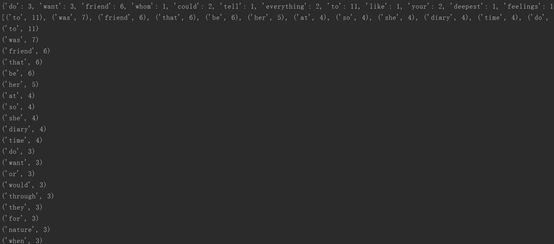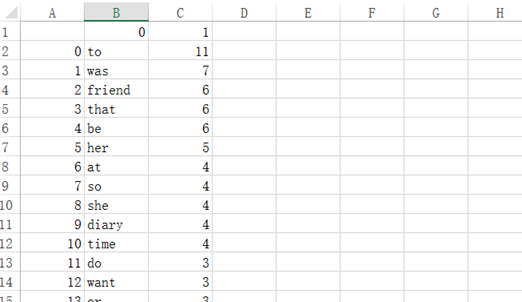复合数据类型,英文词频统计
1 2 3 4 | list=['a','b','c']list.append(['d','q'])list.extend(['e','f'])list.insert(0,1) |

删:
1 2 3 4 5 | list=['a','b','c','d','e','f']del list[0]list.pop()list.remove('e')list.clear() |
查:
1 2 | print(list)print(list[0]) |

改:
1 2 3 | list=['a','b','c','d','e','f']list[0]=1print(list) |

遍历:
1 2 3 4 5 6 | for i in list: print(i,end='')for i in range(len(list)): print(list[i],end='')for index,value in enumerate(list): print(index,value) |

2、元组
增:
1 2 3 4 | tupA=('a','b','c','d','e','f')tupB=('q','m')tupC=tupA+tupBprint(tupC) |

删:
1 | del tupC |
查:
1 2 | print(tupC)print(tupC[0]) |

改:
元组不能修改
遍历:
1 2 3 4 5 6 | for i in tupA: print(i,end='')for i in range(len(list)): print(tupA[i],end='')for index,value in enumerate(tupA): print(index,value) |

3、字典
增:
1 2 3 4 | dict={'a':1,'b':2,'c':3,'d':4}dict['e']=5dict.update({'f':6,'g':7})print(dict) |

删:
1 2 3 4 | dict={'a':1,'b':2,'c':3,'d':4}del dict['a']dict.pop('d')print(dict) |

查:
1 2 | dict={'a':1,'b':2,'c':3,'d':4}print(dict['a']) |

改:
1 2 3 4 | dict={'a':1,'b':2,'c':3,'d':4}dict.update({'a':9999})dict['b']=999print(dict) |

遍历:
1 2 3 4 5 6 7 8 9 | dict={'a':1,'b':2,'c':3,'d':4}for i in dict.items(): print(i)for i in dict.keys(): print(i)for i in dict.values(): print(i)for i,j in dict.items(): print(i,j) |

4、集合
增:
set={'a',1,2,'c','d'}
set.update({'qq':1})
set.update([1,2,3])
set.add('bb')
print(set)

删:
1 2 3 4 5 6 | set={'a',1,2,'c','d'}set.discard('qqqq')set.remove('a')set.pop()set.clear()print(set) |
查:
1 2 | set={'a',1,2,'c','d'}print(set) |

改:
没有修改的方法
遍历:
1 2 3 | set={'a',1,2,'c','d'}for i in set: print(i,end='') |

二.总结列表,元组,字典,集合的联系与区别。
1、列表的括号是"[ ]" ,元组的括号是”( )“,字典的括号和集合的括号都是”{ }“;
2、列表与元组都为有序序列,字典与集合为无序序列;
3、列表、字典、集合属于可变序列,而元组属于不可变序列;
4、列表和元组允许重复,而字典和集合不允许重复;
5、列表和元组是可以根据下标进行查找,但元组不可修改,列表可以,字典可根据字典的键名查找相应的值,集合是不允许通过下标进行查询的。
三.词频统计
1.下载一长篇小说,存成utf-8编码的文本文件 file
2.通过文件读取字符串 str
3.对文本进行预处理
4.分解提取单词 list
5.单词计数字典 set , dict
6.按词频排序 list.sort(key=lambda),turple
7.排除语法型词汇,代词、冠词、连词等无语义词
- 自定义停用词表
- 或用stops.txt
8.输出TOP(20)
9.可视化:词云
排序好的单词列表word保存成csv文件
import pandas as pd
pd.DataFrame(data=word).to_csv('big.csv',encoding='utf-8')
线上工具生成词云:
https://wordart.com/create
代码如下:
1 2 3 4 5 6 7 8 9 10 11 12 13 14 15 16 17 18 19 20 21 22 23 24 25 26 27 | import pandas as pdfile=open('artical.txt',encoding='utf-8')text=file.read()text=text.lower()for i in str('''?!",.'''): text=text.replace(i,'')text=text.split()# 统计单词数量exclude = ['a', 'the', 'and', 'if', 'you', 'in', 'but', 'not', 'it', ' s', 'if', "i"]dict={}for i in text: if i not in exclude: if i not in dict: dict[i]=text.count(i)print(dict)# 排序单词数量word=list(dict.items())word.sort(key=lambda x: x[1], reverse=True)print(word)# 输出前二十位的单词for i in range(20): print(word[i])pd.DataFrame(data=word).to_csv('b.csv',encoding='utf-8') |
运行结果:

生成csv文件如下:

生成词云如下:





【推荐】编程新体验,更懂你的AI,立即体验豆包MarsCode编程助手
【推荐】凌霞软件回馈社区,博客园 & 1Panel & Halo 联合会员上线
【推荐】抖音旗下AI助手豆包,你的智能百科全书,全免费不限次数
【推荐】轻量又高性能的 SSH 工具 IShell:AI 加持,快人一步
· 深入理解 Mybatis 分库分表执行原理
· 如何打造一个高并发系统?
· .NET Core GC压缩(compact_phase)底层原理浅谈
· 现代计算机视觉入门之:什么是图片特征编码
· .NET 9 new features-C#13新的锁类型和语义
· Spring AI + Ollama 实现 deepseek-r1 的API服务和调用
· 《HelloGitHub》第 106 期
· 数据库服务器 SQL Server 版本升级公告
· 深入理解Mybatis分库分表执行原理
· 使用 Dify + LLM 构建精确任务处理应用